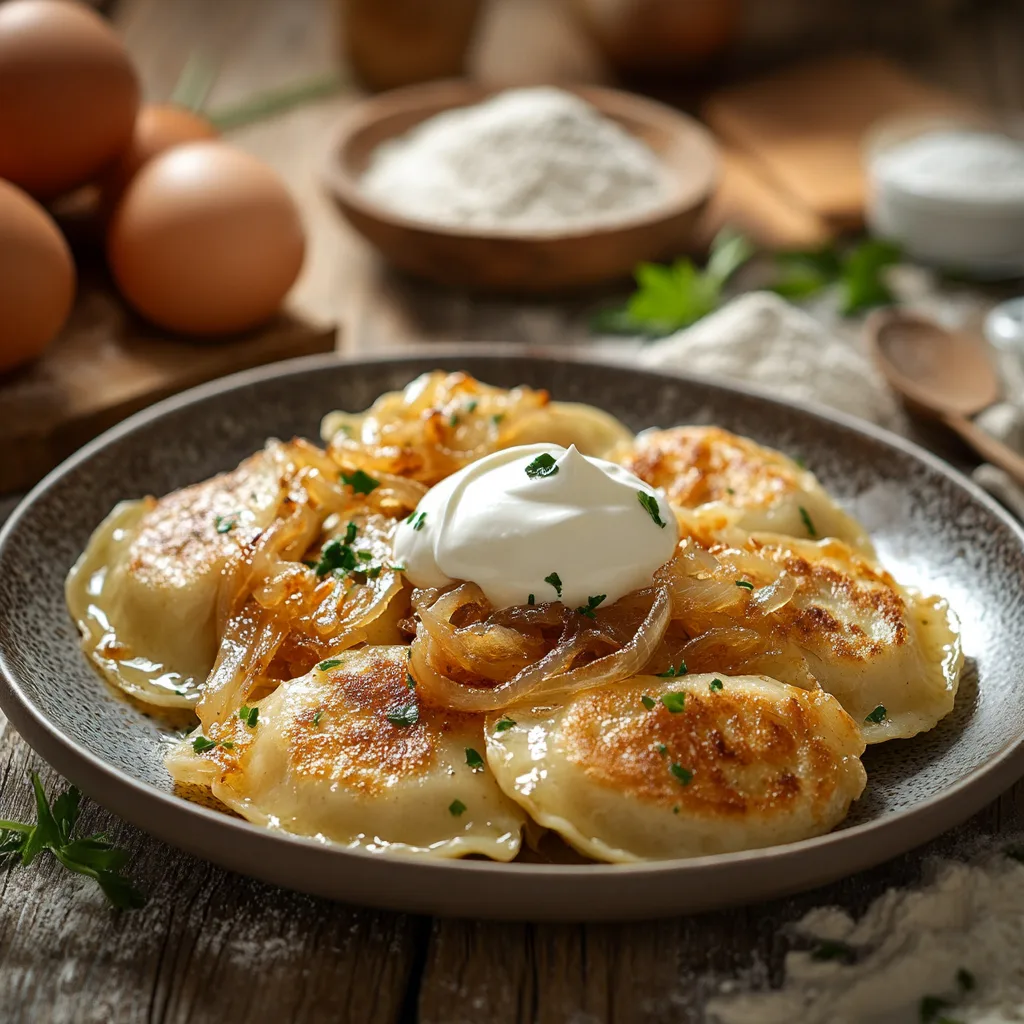Introduction: The Joy of Making Pierogi
Pierogi, the beloved Eastern European dumplings, are a comfort food classic with global appeal. From their pillowy dough to their flavorful fillings, they offer something for everyone—sweet or savory, boiled or fried.
Whether served at a holiday feast or a casual family dinner, pierogi are steeped in tradition and bursting with flavor. They remind us of the satisfying simplicity of home cooking, much like comforting soup recipes or balanced one-bowl meals.
In this complete guide, you’ll learn how to make pierogi from scratch—including dough, fillings, cooking techniques, and storage. You’ll also discover holiday traditions, vegan variations, and pro tips for perfection.
A Brief History of Pierogi
Many people associate pierogi with Polish cuisine, but their origins date back to the 13th century. Influenced by Asian dumplings and spread via trade routes, these filled dough pockets evolved into a cultural staple throughout Eastern Europe.
In Poland, pierogi are eaten year-round, especially during holidays like Christmas Eve (Wigilia), where vegetarian versions are served. They’ve also become popular in Ukraine (as varenyky), Russia (pelmeni), and across the global Polish diaspora.
For a deeper dive into the cultural roots of pierogi, check out the Smithsonian’s article on the history of pierogi.
Types of Pierogi
- Pierogi Ruskie: Mashed potatoes, farmer’s cheese, and onions
- Pierogi z Mięsem: Ground meat with onion and spices
- Pierogi z Kapustą i Grzybami: Sauerkraut and mushrooms (common at Christmas)
- Sweet Pierogi: Blueberries, strawberries, or sweetened cheese
Each variety offers a unique taste experience, yet they all share that *signature soft dough* and satisfying bite.
Essential Ingredients
Dough Ingredients:
- 3 cups all-purpose flour
- 1 large egg (optional)
- ¾ cup warm water
- 2 tbsp vegetable oil or melted butter
- 1 tsp salt
Common Fillings:
- Potato & Cheese: Mashed potatoes, farmer’s cheese, onion, salt & pepper
- Meat: Ground beef or pork, sautéed onions, garlic, spices
- Sauerkraut & Mushroom: Cooked sauerkraut, chopped mushrooms, onion
- Sweet: Fruit (berries or preserves), sweetened cottage cheese, cinnamon
Optional Toppings:
- Sour cream
- Fried onions
- Bacon bits
- Fresh herbs
How to Make Pierogi Dough
Step-by-Step Instructions:
- In a large mixing bowl, combine flour and salt.
- Add the egg (if using), oil or melted butter, and warm water.
- Mix until a rough dough forms. Transfer to a floured surface and knead for 8–10 minutes.
- The dough should be smooth, elastic, and slightly tacky—not sticky.
- Cover with a towel or plastic wrap and let it rest for 30 minutes at room temperature.
This resting period relaxes the gluten, making the dough easier to roll and shape.
Tip: For more guidance, refer to this step-by-step pierogi dough tutorial.
Rolling and Cutting the Dough
Instructions:
- Divide rested dough into four pieces. Keep unused portions covered to prevent drying.
- Roll each section out to about 1/8-inch thick on a lightly floured surface.
- Use a round cutter or glass (about 3 inches wide) to cut circles from the dough.
Dust the dough circles lightly with flour and stack them gently with parchment paper between layers if preparing in advance.
Making the Fillings
Potato & Cheese (Pierogi Ruskie):
- Boil 3–4 peeled potatoes until fork-tender. Drain and mash.
- Mix in 1 cup crumbled farmer’s cheese, sautéed onions, salt, and pepper.
- Let the mixture cool before using as filling.
Sauerkraut & Mushroom:
- Sauté onions and mushrooms in butter or oil until golden.
- Add drained, chopped sauerkraut and cook for 10–15 minutes.
- Season with pepper and caraway if desired. Cool before filling.
Sweet Cheese Filling:
- Combine cottage cheese with sugar, egg yolk, and a pinch of cinnamon.
Sweet fillings pair perfectly with sour cream or fruit sauce after cooking.
Shaping and Sealing Your Pierogi
Once your dough rounds and fillings are ready, it’s time to shape your pierogi. The key is not to overfill and to seal the edges tightly.
Instructions:
- Place 1 teaspoon of filling in the center of each dough round.
- Fold the dough over to form a half-moon shape.
- Pinch the edges tightly with your fingers, or use a fork for decorative sealing.
- Place finished pierogi on a floured tray and cover with a towel.
Don’t stack them or they may stick together. If needed, refrigerate shaped pierogi for up to 2 hours before cooking.
How to Cook Pierogi
🥣 Boiling (Traditional Method)
- Bring a large pot of salted water to a rolling boil.
- Gently drop in 6–8 pierogi at a time.
- Cook until they float, then 1–2 minutes longer.
- Remove with a slotted spoon and drain.
🍳 Pan-Frying
Many people enjoy boiled pierogi pan-fried in butter for extra crispiness.
- Heat butter or oil in a skillet over medium heat.
- Add boiled pierogi and fry 2–3 minutes per side until golden brown.
- Serve hot with toppings like onions or sour cream.
🔥 Baking or Air Frying
- Oven: Brush pierogi with butter and bake at 375°F (190°C) for 15–20 minutes, flipping once.
- Air Fryer: Preheat to 370°F and cook for 8–10 minutes, shaking the basket halfway through.
These methods work great for reheating leftovers or cooking from frozen.
How to Store and Freeze Pierogi
Refrigerator:
- Cooked pierogi: Store in an airtight container for up to 4 days.
- Uncooked pierogi: Refrigerate for no more than 1 day, covered in plastic wrap.
Freezing Instructions:
- Place uncooked pierogi in a single layer on a parchment-lined baking sheet.
- Freeze until solid (about 1–2 hours).
- Transfer to freezer bags and label. Store for up to 3 months.
To Cook from Frozen:
- Boil straight from the freezer — do not thaw.
- Once they float, cook 3–5 minutes longer than fresh pierogi.
Serving Suggestions and Toppings
Classic Savory Toppings:
- Sauteed onions in butter
- Chopped crispy bacon or pancetta
- Sour cream and fresh dill
For Sweet Pierogi:
- Sugar and cinnamon dusting
- Fruit preserves or berry compote
- Whipped cream or sour cream sweetened with honey
Pair Pierogi With:
- Borscht or clear beet soup
- Fresh cucumber salad
- Healthy grilled chicken with roasted vegetables for a balanced plate
Whether served as an appetizer, entrée, or dessert, pierogi are an adaptable delight.
Regional and Cultural Variations
🇵🇱 Poland:
- Ruskie: Potato and cheese
- Meat-filled: Ground pork or beef, often from leftover roasts
- Kapusta i Grzyby: Sauerkraut and mushroom — popular at Christmas
🇺🇦 Ukraine – Varenyky:
Often filled with cherries, cabbage, or sweet cheese, and topped with sour cream or butter.
🇷🇺 Russia – Pelmeni:
Smaller, round dumplings usually filled with raw meat and served in broth or vinegar.
🇸🇰 Slovakia & 🇨🇿 Czech Republic – Pirohy:
Often served sweet, with poppy seeds or fruit, and topped with melted butter and powdered sugar.
Modern Dietary Adaptations
🌱 Vegan Pierogi:
- Use oil and warm water in place of egg in dough.
- Fillings: mashed potatoes, caramelized onions, lentils, vegan cheese.
- Toppings: sautéed mushrooms, plant-based sour cream.
🌾 Gluten-Free Pierogi:
- Use 1:1 gluten-free flour blend with xanthan gum.
- Roll carefully — gluten-free dough is more delicate.
💪 High-Protein Variants:
- Stuff with shredded chicken, tofu, or cottage cheese.
- Serve alongside a green salad or street corn rice bowl for added protein and fiber.
Frequently Asked Questions (FAQ)
Can you bake pierogi instead of boiling?
Yes, but it’s best to boil them first. Baking from raw can result in a dry texture.
Do you have to boil pierogi before frying?
Yes. Boiling ensures the dough is cooked through. Then you can pan-fry for a crispy finish.
Can you make pierogi dough ahead of time?
Absolutely. Dough can be made and refrigerated up to 24 hours in advance.
What flour works best?
All-purpose flour works great. Bread flour will add more chew; avoid cake or pastry flour.
How long do pierogi last in the fridge?
Cooked pierogi last up to 4 days. Uncooked ones should be frozen if not cooked the same day.
Can you freeze cooked pierogi?
Yes. Allow them to cool fully, freeze on a tray, then store in a bag. Reheat by pan-frying or boiling.
Common Mistakes to Avoid When Making Pierogi
Even skilled cooks can struggle with pierogi on their first few attempts. Here’s how to avoid the most common pitfalls.
1. Dough Too Tough or Too Sticky
Why it happens: Not enough water (too tough) or too much (too sticky).
Solution: Add water or flour 1 tablespoon at a time as needed while kneading.
2. Dough Ripping When Shaping
Why it happens: Dough too thin or not rested.
Solution: Let dough rest 30 minutes before rolling. Aim for 1/8-inch thickness.
3. Pierogi Open During Cooking
Why it happens: Poor sealing or wet edges.
Solution: Lightly moisten edges before sealing. Avoid overfilling.
4. Waterlogged or Gummy Texture
Why it happens: Overcooking or crowding in the pot.
Solution: Boil in small batches. Remove 1–2 minutes after they float.
5. Stickiness After Cooking
Solution: Toss cooked pierogi with melted butter or oil to prevent sticking.
Holiday and Cultural Significance of Pierogi
In Poland and throughout Eastern Europe, pierogi are more than just a meal — they’re part of tradition, family, and celebration.
🎄 Wigilia (Christmas Eve Dinner)
- Only meatless pierogi (e.g., sauerkraut & mushroom) are served.
- Symbolic of humility and reflection during Advent.
- Shared alongside barszcz (beet soup) and compote.
🕊️ Easter and Other Celebrations
- Sweet cheese and meat pierogi often appear at Easter brunch.
- Popular at weddings, christenings, and birthdays.
🎪 Pierogi Festivals
- Held in Kraków, Pittsburgh, Chicago, and beyond.
- Feature traditional and modern fillings, speed-eating contests, and folk music.
Recommended External Resources
For deeper exploration or trusted references, consider linking to the following:
- King Arthur Baking – Homemade Pierogi Dough
- Polish Housewife – Pierogi Ruskie Recipe
- Smithsonian – History of Pierogi
Final Thoughts: Why You Should Try Homemade Pierogi
Mastering how to make pierogi isn’t just a culinary achievement — it’s a connection to history, heritage, and heart. Whether you fill them with creamy potatoes, tangy sauerkraut, or sweet berries, every batch you make is a celebration of tradition.
From Christmas feasts to weeknight dinners, pierogi bring people together. They freeze beautifully, feed a crowd, and adapt to every taste or diet.
So roll up your sleeves, grab your rolling pin, and start shaping memories — one dumpling at a time.
For more comforting and delicious recipe ideas, explore the full library of home-cooked goodness at CharlieRecipes.com.


3 thoughts on “How to Make Pierogi: Traditional Recipe, Fillings, and Cooking Tips”
Comments are closed.